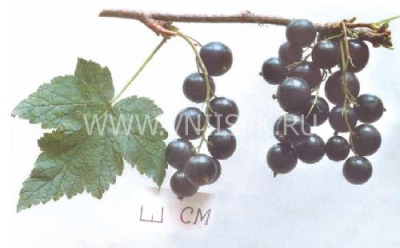
- Authors: A. I. Astakhov, L. I. Zueva (All-Russian Research Institute of Lupine)
- Appeared when crossing: Seedling of Dovewing x Hybrid form 32-77
- Year of approval: 1994
- Ripening terms: early ripening
- Growth type: vigorous
- Appointment: universal
- Berry weight, g: 2-3
- Tasting assessment: 4,6
- Escapes: green, medium, slightly curved, matte, non-pubescent
- Sheet: three-lobed, medium, leathery, wrinkled, green, convex plate
Black currant is a popular shrub that has a pleasant sweet and sour taste and is rich in nutrients. Among the variety of popular berry varieties, Sevchanka stands out. It is worth taking a closer look at the features of the plant.
Breeding history
Sevchanka appeared thanks to the work of a team of breeders from the All-Russian Research Institute of Lupine by crossing two varieties: the Seedling of the Golubki and the Hybrid form 32-77. In 1994, the bush was included in the State Register.
Description of the variety
The roots of the currant are superficial, the maximum depth of occurrence is 45 cm. Slightly spreading bushes of Sevchanka give erect shoots of medium thickness and do not require pruning efforts. Leaves are dark green, characteristic features:
three-bladed;
tough;
leathery;
wrinkled.
Each leaf has a convex plate; the stalk is colored closer to the base. During the flowering period, from 8 to 14 large flowers with yellowish petals bloom on one brush.
Characteristics of berries
With proper care, currant bushes give a generous harvest, the weight of one berry reaches 2.5-3 g. The fruit contains:
sugar;
acids;
soluble solids;
pectin;
vitamins C, P;
anthocyanins and leukoanthocyanins;
polyphenols.
The berries can be eaten raw or used for homemade preparations.
Taste qualities
Sevchanka currant fruits have a sweet and sour taste. The tasting score of the berries is 4.6 points, which is considered a fairly high indicator.
Ripening and fruiting
The first berries appear in the second half of June - early July. It is better to remove the fruit with the stalk.

Yield
From one currant bush, it will be possible to collect up to 2 kg, with careful plant care - up to 2.2 kg. The average yield is 1.6 kg.
Self-fertility and the need for pollinators
The variety is self-fertile, therefore it does not require mandatory pollination.
Landing
Black currant grows well in well-lit areas, loves fertile soil. It is better to plant bushes on flat or with a slight slope, where the shadow of the trees does not reach. An excellent option for planting is the south or southwest side.
It is recommended to plant Sevchanka in the first months of spring before the buds swell. You can also plant currants in the fall - in early or mid September. The second option is more preferable, since the plant will have time to grow stronger by winter, and transfer frost for future flowering and fruiting.
Soil requirements:
slightly acidic or neutral soil with a pH of 5 to 5.5;
loam;
the depth of the groundwater is not higher than 1 m.
It is not recommended to plant currants in sandy or clayey soils. And also you should not choose pits or lowlands for planting, which are characterized by stagnant water. Before planting currants in the soil, it is necessary to apply fertilizers so that the plant quickly takes root and gives a high yield in the future. If you plan to plant a bush in the spring, then from the fall, up to 10 kg of humus, 1 liter of wood ash and superphosphate in an amount of 100 g per 1 m2 are introduced into the prepared holes. The total fertilizer layer thickness should be 2/3 of the hole.
Saplings are planted according to the following scheme.
Holes are dug in the ground.
After fertilization and the expiration of the required period, 4-5 liters of water are poured into each.
Saplings are planted at an angle of 45 degrees, burying the buds 3-4 into the ground.
The roots are carefully straightened.
Sprinkle the plant with earth, carefully ramming it.
Another 4-5 liters of water is poured in.
In order for the plant to absorb enough moisture, the soil should be mulched using peat or compost. After planting, it is recommended to lightly prune the shoots so that 3-4 buds remain above the ground.

Growing and care
Sevchanka does not require special care. Basic recommendations.
Rare and abundant watering without moisture stagnation, which can be detrimental to the plant. It is imperative to water the bush in the spring during the growing season, as well as during flowering and the formation of the first ovaries. In addition, gardeners are advised to add water during the formation of berries and harvesting in order to strengthen the plant's immunity before frost.
Digging grooves up to 30 cm deep at a distance of 25 cm from the tops. During irrigation, water must be poured into the ditches. To keep the soil around the bush moist, it is additionally worth mulching the trunks.
Loosening the soil. The procedure will provide the plant with the necessary amount of oxygen and nutrients.
Fertilization. When Sevchanka reaches the age of three, fertilization of the bush becomes mandatory. Better to use nitrogen and phosphorus compounds. It is especially important to fertilize the bush during the flowering and berry period.
Following the advice of experienced gardeners will help to achieve a high yield.




Disease and pest resistance
The bush is resistant to powdery mildew, fungus and scab. However, as the currants grow, it is recommended to carry out preventive treatment.

Currant is one of the most favorite crops of gardeners, it can be found on almost any personal plot. In order for the currant berries to be tasty and large, and the bush itself to be healthy and strong, you should properly care for, treat and protect the plant from harmful insects. It is important to recognize the signs of the disease in a timely manner and begin treatment in the early stages of plant damage.










































































